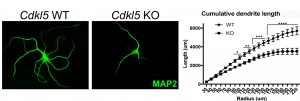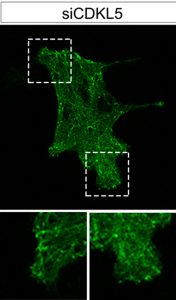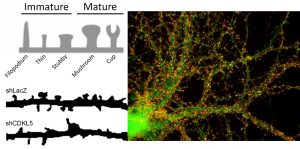- Using a platform of primary cultures of Cdkl5-deficient neurons we are searching for drugs that are capable of reverting the morphological and molecular defects caused by loss of Cdkl5. While we continue searching for new drugs we have already identified two compounds that are capable of normalizing various parameters of Cdkl5-deficient neurons. These drugs will be further studied to fully understand their therapeutic potential.

- Among the molecular networks regulated by CDKL5, we are investigating its role in controlling cytoskeleton dynamics in proliferating cells and post-mitotic neurons.


The microtubule plus-end binding protein CLIP170 fused to GFP was expressed in Cos7 cells silenced for CDKL5 and its association with microtubules analyzed through time-lapse imaging. The stability of the microtubule associaiton of CLIP170 is significantly reduced in the absence of CDKL5.
- CDKL5 plays an important role in regulating synaptic activity and spine maturation; we are particularly interested in understanding the molecular basis for these defects.

Left: Cdkl5-deficient neurons are characterized by the presence of immature spines in correspondence with defects in synaptic plasticity. CDKL5 expression was silenced in primary hippocampal neurons with a shRNA against CDKL5 or as control shLacZ. The morphology of dendritic spines was analyzed after 18 days in culture.
Right: immunofluorescence showing pre- and post-synaptic markers in cultured hippocampal neurons (SYN1, red; GluR2, green).
